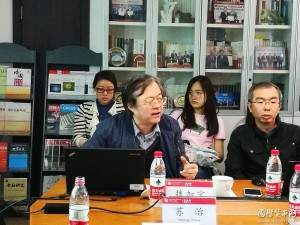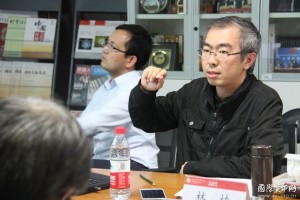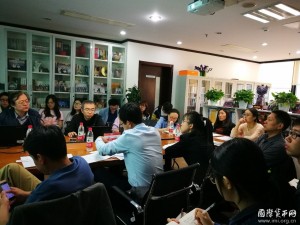Macro-Finance Salon (No. 61): The Possibility of the Outbreak of Financial Crisis in China
2017-04-27 IMI Wei Jianing, by comparing the similarities and differences between the 1997 Asian financial crisis and the 2008 global financial crisis, analyzed how China was connected to these international financial crises. He analyzed China’s role in causing the two crises and the crises’ impact on China. During the two international financial crises, China suffered from deflation, but China was in different economic stages with different investment rates of return, the measures and effects responding the two international financial crises are also different. By analyzing China’s current debt burden, capital outflows, economic growth and structure, and by evaluating the possibilities and impacts of each risk, he believes that China needs to be aware of the real estate bubble burst and overcapacity. Turning to the relationship between reform and financial risk, Wei Jianing stressed that it is necessary to distinguish three different risks, and treat them differently, that is, the risk brought by reform, the risk of carrying out reform and the risk of improper or improper reform. At last, Wei Jianing put up with some advice on China's economic and financial reform. He believes that in the short term, risk assessment and crisis response plans are needed; in the medium term, an effective risk prevention and crisis pre-warning mechanism and plans to gradually resolve the risk is needed; in the long term, to effectively promote structural reform is fundamental to avoid crisis.
Wei Jianing, by comparing the similarities and differences between the 1997 Asian financial crisis and the 2008 global financial crisis, analyzed how China was connected to these international financial crises. He analyzed China’s role in causing the two crises and the crises’ impact on China. During the two international financial crises, China suffered from deflation, but China was in different economic stages with different investment rates of return, the measures and effects responding the two international financial crises are also different. By analyzing China’s current debt burden, capital outflows, economic growth and structure, and by evaluating the possibilities and impacts of each risk, he believes that China needs to be aware of the real estate bubble burst and overcapacity. Turning to the relationship between reform and financial risk, Wei Jianing stressed that it is necessary to distinguish three different risks, and treat them differently, that is, the risk brought by reform, the risk of carrying out reform and the risk of improper or improper reform. At last, Wei Jianing put up with some advice on China's economic and financial reform. He believes that in the short term, risk assessment and crisis response plans are needed; in the medium term, an effective risk prevention and crisis pre-warning mechanism and plans to gradually resolve the risk is needed; in the long term, to effectively promote structural reform is fundamental to avoid crisis.
 Xiong Yuan shared his view on the possibility of financial crisis outbreak in China from the perspective of “debt and capital outflows’ relation to the financial crisis”. He believes that the outbreak of financial crisis is often accompanied by debt and capital outflows. According to his study of international experience and historical data, he found that debt to a certain extent will drag on economic growth and increase the possibility of crisis outbreak. Then, Xiong Yuan compared the debt levels and trends of the United States, Europe, Japan with China, and found that China’s overall leverage and leverage in sectors (of residents, governments, non-financial enterprises, financial institutions) are on the rise. This is significantly different from the United States and Europe. When it comes to capital outflow, he took the chronological relations between the Strong Dollar cycle and the financial crisis as an example, explained the influence of international capital flow on the financial crisis. He pointed out that the RMB exchange rate continued to come under pressure, foreign exchange reserves shrunk dramatically, net outflow of the erred and omitted projects continued to expand, all show that China is facing greater pressure on capital outflows. But China was doing better in guarding against risks, the economic downturn is expected to bottom out. The economic performance of the first quarter of 2017 was good, the pressure to maintain growth eased. At the same time, regulatory measures to guard against risks, deleverage, price bubble are being strengthened. He therefore believes that China may be hard to avoid local, event crisis, but there will be no comprehensive, systematic financial crisis.
Xiong Yuan shared his view on the possibility of financial crisis outbreak in China from the perspective of “debt and capital outflows’ relation to the financial crisis”. He believes that the outbreak of financial crisis is often accompanied by debt and capital outflows. According to his study of international experience and historical data, he found that debt to a certain extent will drag on economic growth and increase the possibility of crisis outbreak. Then, Xiong Yuan compared the debt levels and trends of the United States, Europe, Japan with China, and found that China’s overall leverage and leverage in sectors (of residents, governments, non-financial enterprises, financial institutions) are on the rise. This is significantly different from the United States and Europe. When it comes to capital outflow, he took the chronological relations between the Strong Dollar cycle and the financial crisis as an example, explained the influence of international capital flow on the financial crisis. He pointed out that the RMB exchange rate continued to come under pressure, foreign exchange reserves shrunk dramatically, net outflow of the erred and omitted projects continued to expand, all show that China is facing greater pressure on capital outflows. But China was doing better in guarding against risks, the economic downturn is expected to bottom out. The economic performance of the first quarter of 2017 was good, the pressure to maintain growth eased. At the same time, regulatory measures to guard against risks, deleverage, price bubble are being strengthened. He therefore believes that China may be hard to avoid local, event crisis, but there will be no comprehensive, systematic financial crisis.
 Lin Nan's speech mainly revolves around the exchange rate and the foreign exchange risks under the “new normal”. He pointed out that foreign exchange risk may not be “qualitative change” caused by the risk but “quantitative change” in risk transmission and accumulation. Combined with the industrial capital cycle in Marx's Capital, under the framework of “production, market and currency”, exchange rate is one of the main line. In terms of production, exchange rate is affected both by economic fundamentals and the factor pricing such as supply-side labor and capital. In terms of market, foreign exchange supply and exchange rate (volume-price relationship) are associated with changes in current account, savings and investment (CA = S-I). In the open conditions, in terms of external risk transmission and risk within, whether the exchange rate is a "buffer" or an "accelerator" is worthy of attention. In terms of currency, the exchange rate is closely linked to the local currency issue (by foreign exchange reserves). To “ensure exchange rate” or “ensure foreign reserve” in exchange rate dynamism need to draw on not only risk hint from balance of payments but also the “de-foreignized” evaluation on the central bank's balance sheet. The RMB exchange rate against the US dollar in the future (when the US dollar exchange rate index depreciates) may appreciate or, in the future, stabilize. That “RMB doesn’t have a derogatory base” is not only from the economic fundamentals, but also the Sino-US monetary policy for the exchange rate. The key is a two-way plan in precaution to both devaluation and appreciation of the exchange rate (and price). The devaluation does not lead to a loss of confidence, appreciation does not lead to an overdraft of the real economy.
Lin Nan's speech mainly revolves around the exchange rate and the foreign exchange risks under the “new normal”. He pointed out that foreign exchange risk may not be “qualitative change” caused by the risk but “quantitative change” in risk transmission and accumulation. Combined with the industrial capital cycle in Marx's Capital, under the framework of “production, market and currency”, exchange rate is one of the main line. In terms of production, exchange rate is affected both by economic fundamentals and the factor pricing such as supply-side labor and capital. In terms of market, foreign exchange supply and exchange rate (volume-price relationship) are associated with changes in current account, savings and investment (CA = S-I). In the open conditions, in terms of external risk transmission and risk within, whether the exchange rate is a "buffer" or an "accelerator" is worthy of attention. In terms of currency, the exchange rate is closely linked to the local currency issue (by foreign exchange reserves). To “ensure exchange rate” or “ensure foreign reserve” in exchange rate dynamism need to draw on not only risk hint from balance of payments but also the “de-foreignized” evaluation on the central bank's balance sheet. The RMB exchange rate against the US dollar in the future (when the US dollar exchange rate index depreciates) may appreciate or, in the future, stabilize. That “RMB doesn’t have a derogatory base” is not only from the economic fundamentals, but also the Sino-US monetary policy for the exchange rate. The key is a two-way plan in precaution to both devaluation and appreciation of the exchange rate (and price). The devaluation does not lead to a loss of confidence, appreciation does not lead to an overdraft of the real economy.
 In the discussion session, our invited guests had an in-depth discussion on the financial risk of China, and exchanged ideas on enterprise leverage ratio, risks and precautions in the “Belt and Road” Initiatives, ways for China to make better use of the advantages of the “big government”, and supply-side structural reform.
In the discussion session, our invited guests had an in-depth discussion on the financial risk of China, and exchanged ideas on enterprise leverage ratio, risks and precautions in the “Belt and Road” Initiatives, ways for China to make better use of the advantages of the “big government”, and supply-side structural reform.
